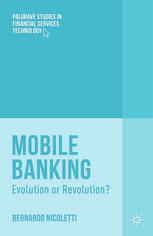

Most ebook files are in PDF format, so you can easily read them using various software such as Foxit Reader or directly on the Google Chrome browser.
Some ebook files are released by publishers in other formats such as .awz, .mobi, .epub, .fb2, etc. You may need to install specific software to read these formats on mobile/PC, such as Calibre.
Please read the tutorial at this link: https://ebookbell.com/faq
We offer FREE conversion to the popular formats you request; however, this may take some time. Therefore, right after payment, please email us, and we will try to provide the service as quickly as possible.
For some exceptional file formats or broken links (if any), please refrain from opening any disputes. Instead, email us first, and we will try to assist within a maximum of 6 hours.
EbookBell Team

4.0
26 reviewsThis book analyzes mobile
banking. It begins by reviewing the transformation of financial institutions.
Then, it moves to in-depth discussions of the functionalities available and
possible with mobility. The book deals with the management of mobile banking,
its risks but also the remediation and especially the opportunities. It
concludes with a glimpse into the future.
The book deals with the aspects
of the management, the functionality, the processes, the technology, and the
structural points of view.
The author provides arguments in
support of the following thesis :
• Financial services must become
more • agile and flexible in the conduct of their business in order to increase
revenues and decrease costs. This means that financial services need to become leaner
and adopt in an increasingly way automation. The adoption of new paradigms, new
processes, and technological components based on mobile can lead to the
achievement of more revenues, cost efficiency and control, increased pace of
innovation, and especially business agility.
• Mobile banking is a disruptive innovation. A
disruptive innovation helps create new markets and value networks.2It
eventually goes on to disrupt existing markets and value networks (over a few years
or decades), by displacing earlier models. A disruptive innovation improves a
product or a service in ways that the market does not expect, typically, first,
by a design aimed at a different set of customers in a new market and, later,
by lowering prices in the existing markets and changing the business world and possibly
also social models.
This book describes how mobile banking can help
transform financial institutions in terms of new products, new processes, new
organizations, and new business models. This book moves from a vision of the
future financial institution to a possible strategy. Practitioners should
select tactical ways to progress. An excellent approach to moving in this
direction is “Lean and Digitize.”3
The aim of the author in writing this book is to
provide useful advices to managers, consultants, practitioners, academicians,
and students.